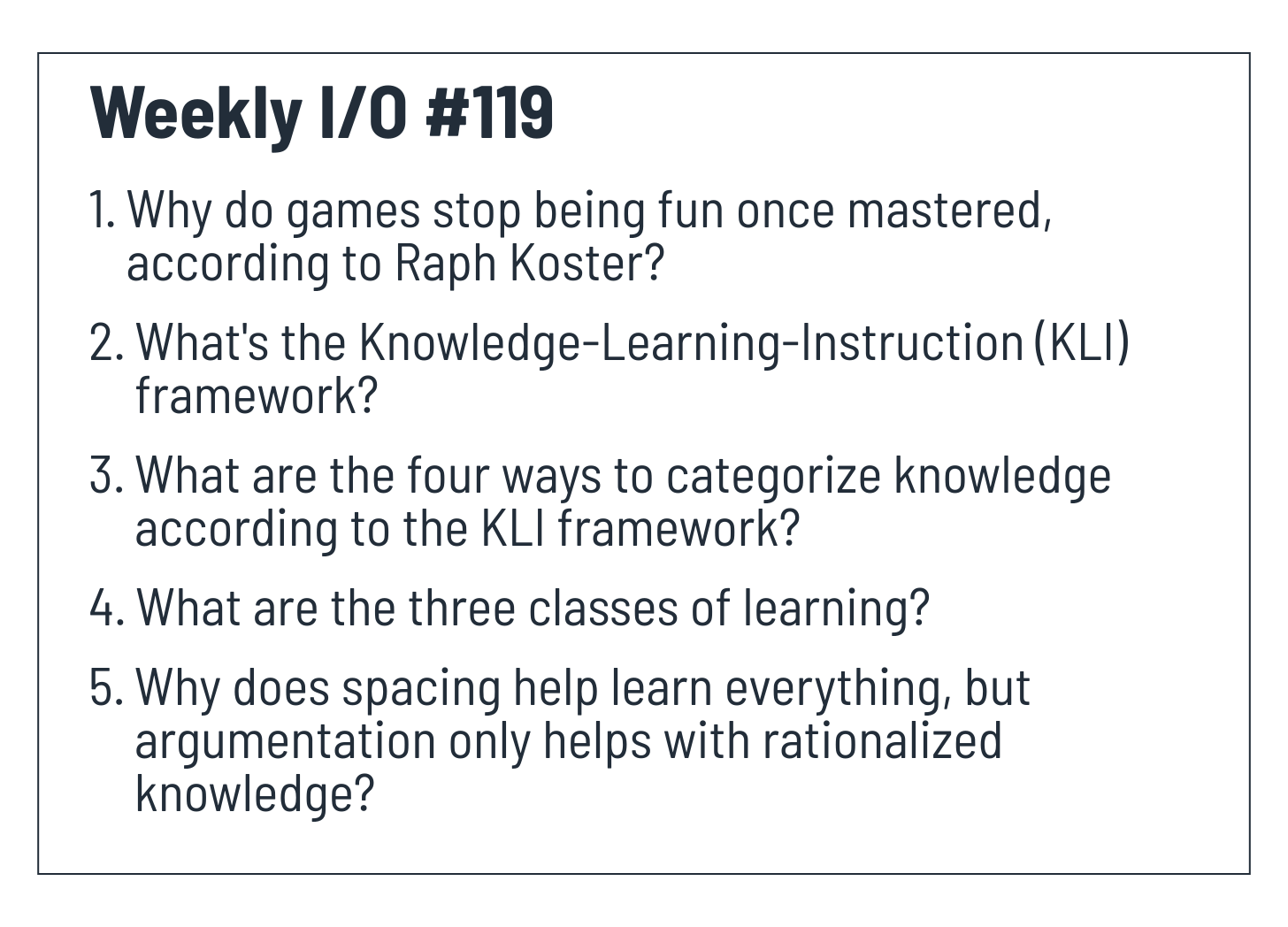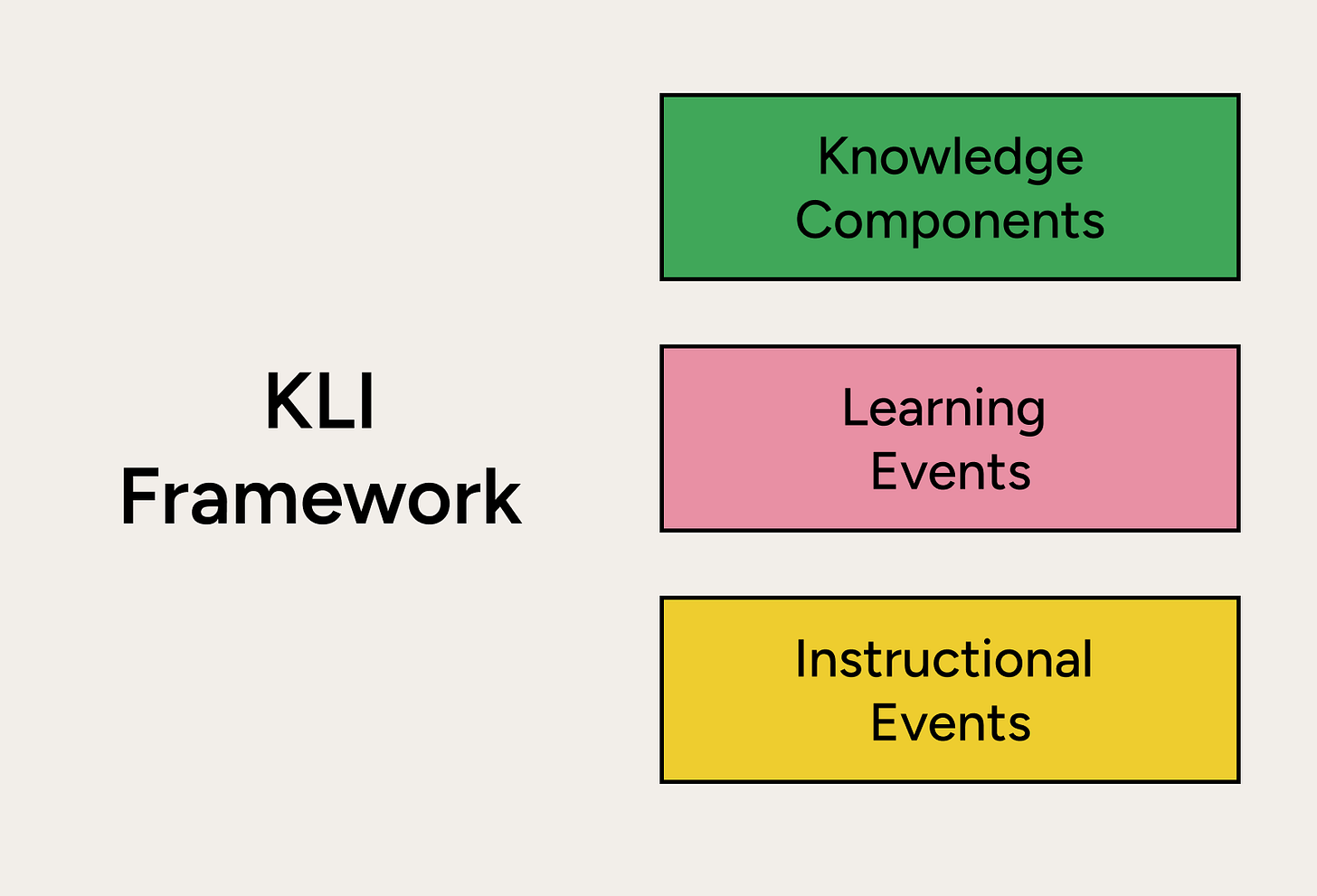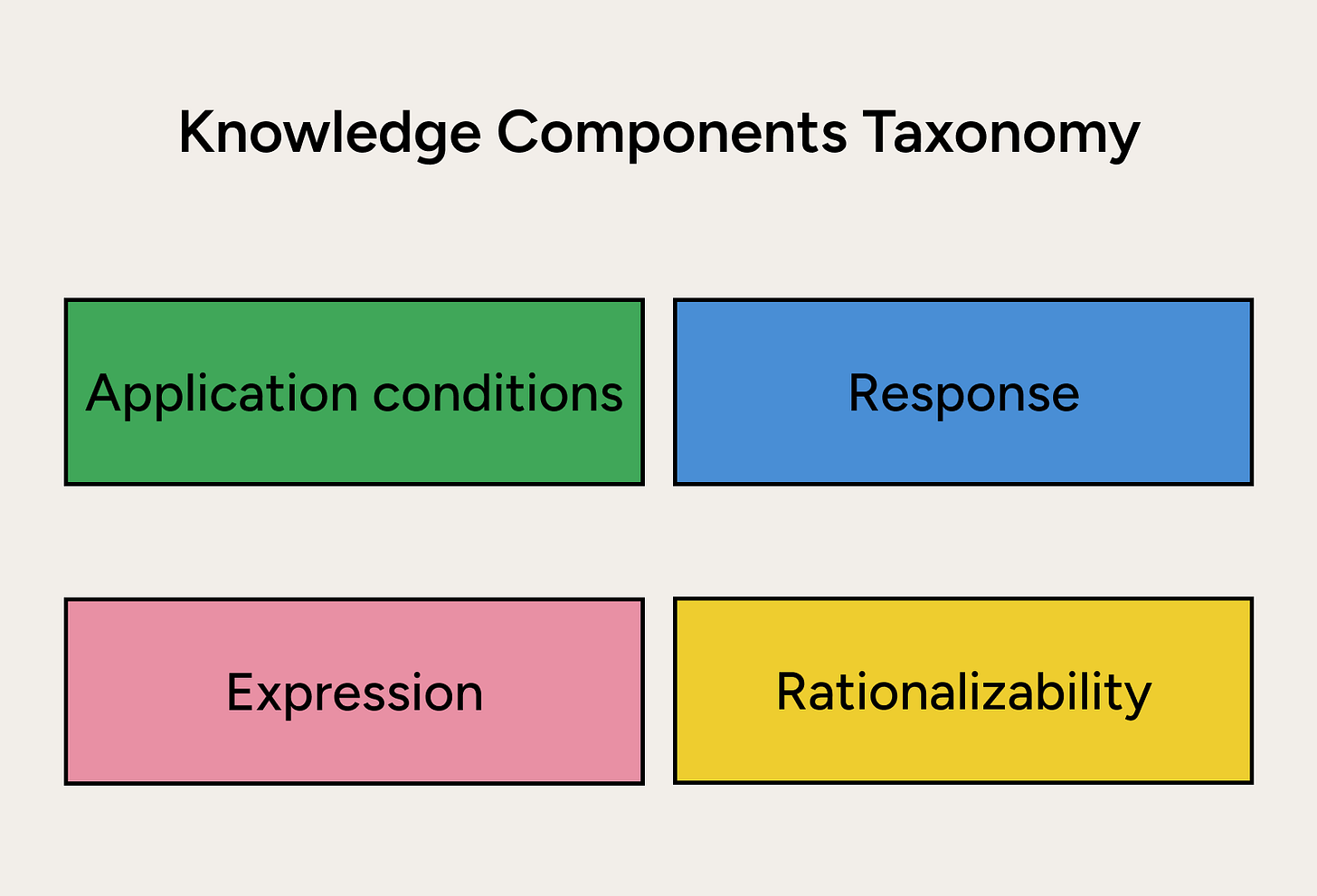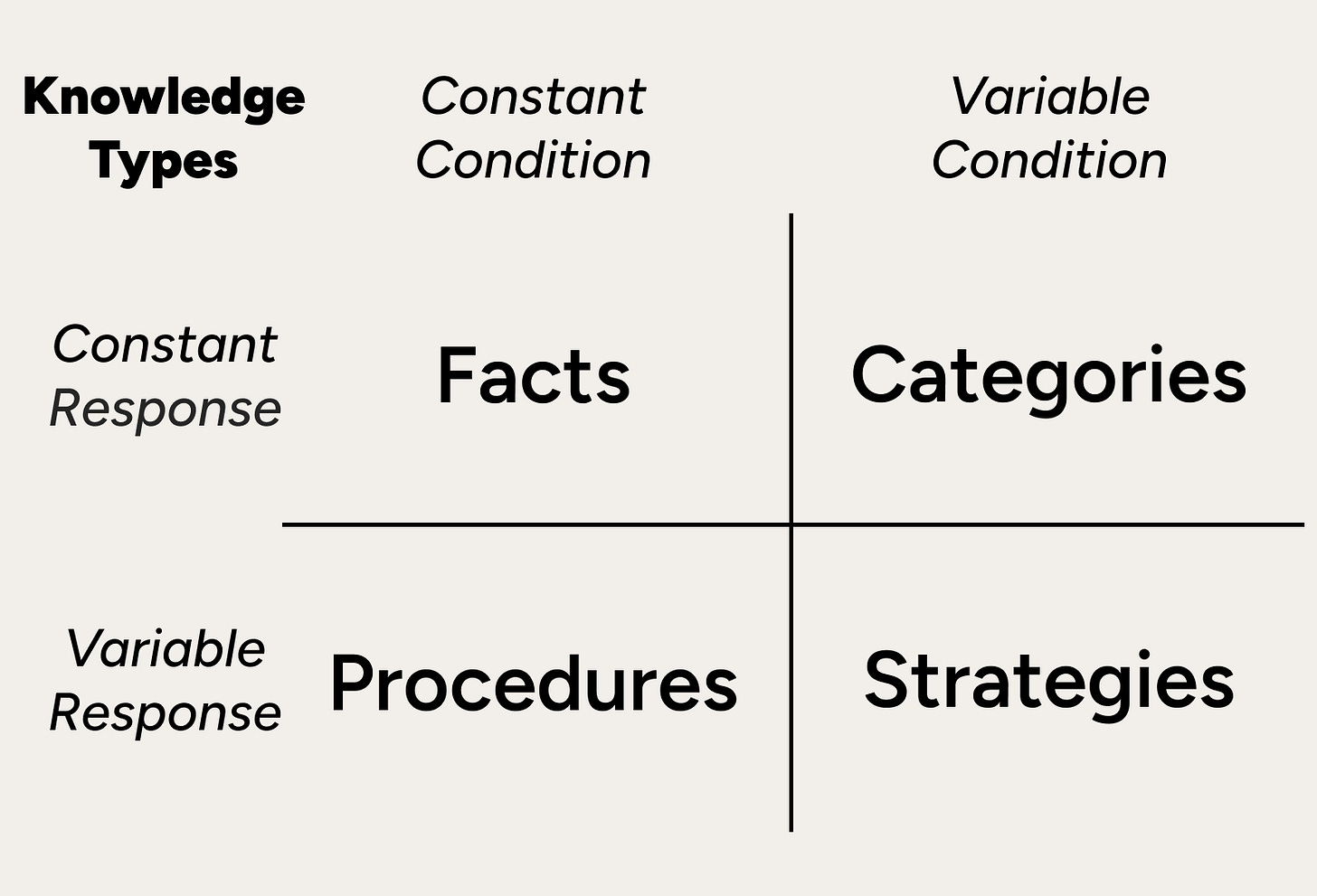Fun is unfinished learning, How to teach, Different types of knowledge
Weekly I/O #119: Games are Tasty Patterns, KLI Framework, Knowledge Components Taxonomy, Three Classes of Learning, Instruction-Knowledge Asymmetry
Hey friends,
Most of the inputs this week are from a Cognitive Science paper I really enjoy reading. Hope you will find it helpful too.
Thank you, Ying-Jui Tseng, for recommending the source to me. And as always, feel free to send me any interesting ideas you came across recently.
Happy learning!
Help you absorb better with Forward Testing Effects
Input
1. Games are tasty patterns for your brain to eat. Fun happens when your brain chunks information into mastery, moving from conscious learning to automatic pattern recognition. But once the patterns are solved, we need new ones to stay motivated.
Book: Theory of Fun for Game Design
In Five Definitions of Game, I talked about my favorite definition of game:
“A game is a problem solving activity, approached with a playful attitude”.
But here’s another one I recently learned from game designer Raph Koster:
“Games are just exceptionally tasty patterns to eat up.”
Our brains constantly crave patterns. Games feed this hunger. (Related: Curiosity is pain.)
When you first learn a game, you process every rule separately. With practice, you begin to recognize patterns. You combine individual actions into meaningful units. In cognitive science, this is known as chunking.
For example, a beginner chess player thinks about each piece while an experienced player sees entire positions as single concepts.
As you refine your understanding, your chunk size gets bigger, and conscious learning becomes automatic. You don’t just remember the facts. You feel it instinctively, like a musician improvising, an athlete performing reflexively. Gameplay becomes fluid.
However, your brain’s goal is efficiency. It turns repeated actions into automatic routines to save energy for new challenges. Once you’ve solved a game’s patterns, your brain has “eaten” all the interesting bits.
This is why tutorials feel tedious once you know the game, why speedrunners keep finding new challenges.
This phenomenon extends beyond gaming. We enjoy activities most when we’re still discovering, chunking, and growing. Once the patterns are solved, we need new ones.
2. The Knowledge-Learning-Instruction (KLI) framework connects three essential pieces in learning: Knowledge Components (what to learn) determine Learning Events (how learning happens), which then constrains Instructional Events (how teaching helps).
Why do debates about teaching methods never end? For example, should we use spaced repetition, worked examples, or open discussion?
These debates persist because we treat teaching methods as always good or always bad. But effectiveness depends on what you’re teaching.
In 2012, researchers at Carnegie Mellon University and the University of Pittsburgh developed the Knowledge-Learning-Instruction (KLI) framework to provide a systematic answer. It connects three coordinated taxonomies:
Knowledge Components define what to learn. They are the units of cognitive function students must acquire, ranging from simple facts to complex skills.
Learning Events describe how learning happens. They are the unobservable cognitive changes that occur during learning, including memory strengthening, pattern induction, and sense-making.
Instructional Events create conditions for learning. They are the observable activities teachers design to trigger learning, such as spacing practice, providing feedback, or facilitating discussion.
The framework shows dependencies. Certain knowledge types require specific brain processes, which then require specific teaching methods. You can’t teach vocabulary the same way you teach problem-solving.
Therefore, good teaching isn’t finding one best method. It’s matching instruction to what students need to learn.
The KLI framework reminds me of the common factors in psychotherapy, which have a somewhat opposite conclusion. Success in teaching has a high dependency on the type of knowledge and specific method, but success in psychotherapy is not so much about specific techniques, but rather common factors such as a sense of shared goals.
3. Knowledge Components Taxonomy: Knowledge can be categorized by four key features: constant or variable application conditions, constant or variable responses, verbal or non-verbal expression, and rationalized or memorized understanding.
We know that not all knowledge is equal, but how can we categorize knowledge in a way that helps us learn it?
The KLI framework identifies four distinctions:
Application conditions: Constant (always the same cue) or variable (cue changes by situation). This refers to when knowledge applies.
The Chinese word “月” always means “moon” (constant). Choosing the English word “the” or “a” depends on context (variable).
Response: Constant (same answer every time) or variable (answer changes). This refers to what the learner produces.
“What’s Earth’s gravity?” Always 9.8 m/s² (constant). Pluralizing rules depend on the word (variable). For example, “city” to “cities” (”y” to “ies.”) and “cat” to “cats”.
Expression: Verbal (can be stated in words) or non-verbal (shown through action). This distinguishes how knowledge is expressed.
You can say the circle area formula (verbal). You can balance on a bike but struggle to explain how (non-verbal).
Rationalizability: Can be logically understood or must be memorized. This refers to the extent to which knowledge can be rationalized.
Why we pluralize certain ways has phonological reasons (rationalized). Why “H” means hydrogen is just a convention (memorized).
These distinctions provide a framework for categorizing knowledge. For example, combining the first two distinctions (Application conditions-Response):
Constant condition, constant response: Facts like “9.8 m/s²” or “Paris is the capital of France”
Variable condition, constant response: Categories like “small volumes use milliliters”
Constant condition, variable response: Procedures like “given circle radius, calculate its area with formula”
Variable condition, variable response: Strategies like “to find the area of irregular shapes, decompose them into regular shapes, and sum”
Complexity increases from constant-constant facts to variable-variable strategies and different knowledge types need different teaching. This taxonomy provides a systematic language to discuss these differences and identify the most effective way to acquire a specific type of knowledge.
4. Learning happens through three classes of processes: “memory and fluency” strengthens knowledge, “induction and refinement” improves accuracy, and “understanding and sense-making” creates verbally mediated knowledge. Each needs different teaching methods.
After introducing different types of knowledge, the KLI framework then identifies three learning processes:
Memory and fluency enhance and accelerate knowledge. Each recall makes information more accessible. You might start by calculating 7 × 8, but soon you just know 56.
They also link knowledge into chunks. Learning to drive requires focus on each action, but practice makes steps automatic. Methods such as spacing (spreading practice) and testing (retrieving information) enhance retention across most knowledge types.
Induction and refinement improve accuracy through generalization and discrimination. A child learns “dog” covers many breeds (generalization) but not cats (discrimination).
This process often happens implicitly. You detect patterns without consciously noticing change. Helpful methods include timely feedback, worked examples, and fading (gradually removing support). These build precise, flexible knowledge.
Understanding and sense-making create knowledge through reasoning. When students explain ideas, they form deeper connections.
This transforms learning. You might catch a ball through practice, but physics adds insight. Strategies like self-explanation, accountable talk (structured discussion), and contrasting cases (comparing approaches) deepen conceptual understanding.
Each process supports different kinds of knowledge. Facts rely on memory, variables on induction, and principles on sense-making. Different methods fit different knowledge types.
5. The Asymmetry Hypothesis suggests that complex knowledge benefits from both complex and straightforward learning methods. But simple knowledge only benefits from simple methods.
Consider two possible relationships between knowledge and teaching:
The Alignment Hypothesis suggests instructional complexity should match knowledge complexity. Simple knowledge needs simple instruction. Complex knowledge needs complex instruction.
The Asymmetry Hypothesis suggests a different pattern. Simple instructions remain effective even for complex knowledge. But complex instruction only works for complex knowledge.
The KLI framework proposes that the Asymmetry Hypothesis is the correct relationship.
Spaced practice is simple. It works for facts (memorizing vocabulary) and principles (retaining understanding of evolution). Even complex knowledge must be remembered. (like using memory technique to learn quantum computing)
Argumentation is complex. It works for principles (discussing why evolution happens) but not facts (arguing why “H” represents hydrogen is pointless—there’s no rationale).
Complex knowledge benefits from both complex and straightforward methods. Simple knowledge only benefits from simple methods.
This explains patterns in research. Worked examples help novices learn algebra, but don’t help memorize facts. They show “expertise reversal”: beneficial early, but later, straight practice works better.
Links
Here’s a list of things I enjoyed learning/relearning this week:
Recap
Try answering these five simple questions to review and reinforce what you’ve learned:
Thanks for reading!
One small favor: please share which input you found the most helpful or intriguing! Just comment on Substack with a number!
It only takes 6 seconds to like and comment, while writing each newsletter takes me 6 hours 🫶
And as always, feel free to send me any interesting ideas you came across recently!
Looking forward to learning from you,
Cheng-Wei
Subscribe to Cheng-Wei’s Update | Subscribe to 程維的中文更新 | Subscribe to Weekly I/O | Facebook | Twitter








I had not thought about learning and knowledge in frameworks and it was an interesting read. KLI was interesting 2-3